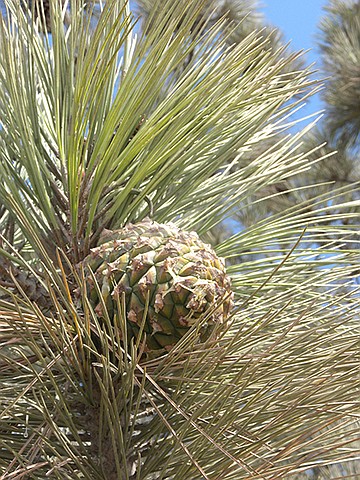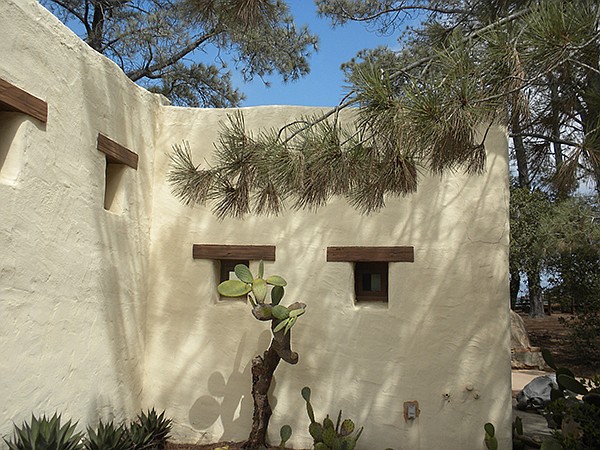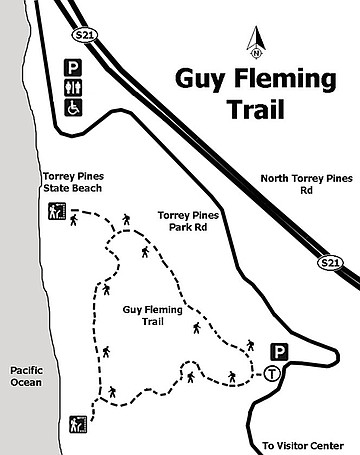 Facebook
Facebook
 X
X
 Instagram
Instagram
 TikTok
TikTok
 Youtube
Youtube


Torrey Pines State Natural Reserve is one of the most beautiful places to walk in San Diego. The reserve has ocean views from most trails, striking red and white sandstone outcrops, and interesting plants and flowers, including the rare Torrey pine. This rare pine grows naturally only here, the La Jolla–Del Mar area, and on Santa Rosa Island, one of the Channel Islands — making it the rarest pine in the country.
The most popular walk in the reserve is the Guy Fleming Trail, named for the first caretaker of the park in 1921. He was hired by both Ellen Browning Scripps and the city to take care of their respective properties. Guy Fleming was also a Fellow at the San Diego Natural History Museum and was instrumental in recommending and including the Anza-Borrego Desert in the original state-park survey authorized by the newly formed State Park Commission in 1928. Fleming was later appointed district superintendent for all Southern California state parks in 1932.
For first-time visitors, the lodge/visitor center is a great place to park. It is a small museum with displays of the history and natural history of the Torrey pine and the reserve. Ellen Browning Scripps constructed the Torrey Pines Lodge in a southwest pueblo style that was popular in 1922. She wanted to help draw attention to the pines and their need for protection. She had previously purchased land with several groves of pines, including the lodge land that was later incorporated into the park.

Walk back downhill on the paved road to the signed North Grove Guy Fleming trailhead on the left. It is a loop, so either way is good with this description turning right at the start. Abundant examples of chaparral plants include lemonade berry, laurel sumac, and prickly pear cactus. There are Torrey pines sandstone crops that are mostly stark white unless capped by the iron oxide-rich Lindavista Formation, which then stains the white a light brown. Torrey pines sandstone is a sedimentary formation that was deposited as a sandbar in the Eocene age where calcite bonded the composition of mostly quartz with some feldspar. The Lindavista Formation was deposited over the Torrey Pines sandstone a mere million years ago while the ocean retreated from the area.
The trail winds through old groves of Torrey pines and opens up to wonderful ocean views with cactus and low sage scrub vegetation. The north overlook has views of the ocean where sometimes whales can be seen as well as Torrey Pines State Beach and the brackish water in Peñasquitos Lagoon. Look at how the wind has shaped the trees and stunted the height of plants along the trail.

The south overlook can be closed when a wedding is performed, but when open and on a clear day, you can view the San Clemente and Santa Catalina islands. The trail now turns east where there is coastal sage scrub, which is an endangered habitat that occurs mostly in dry areas but also along the foggy coast and inland areas where the marine layer reaches. Plants tend to be soft-leafed, drought-deciduous, and may only reach two meters in height. Toward the end of the loop is chaparral, which is the dominant habitat of Southern California, consisting of woody plants that have sclerophyllous or stiff leaves that can be waxy or small as in lemonade berry or the most common plant, chamise. There is a bench at the end of the trail to take a rest before returning to your starting location.
Torrey Pines started out as a city park in 1899 when it was noted that these rare pines needed protection. Due to the special nature of the pines and surrounding acreage, this area has been designated a natural reserve, a more protected designation than a state park. Today, over 2000 acres are preserved. Because this reserve was saved at an early date, it is a wonderful example of what the San Diego area was like before all the development along the coastline. There are certain places on the trails where you can feel like you are in a wild place that has not seen the hand of man. Review the trail map and information hand-out so you know how to protect the reserve.
A hike any time of the year is great for enjoying ocean views and the picturesque wind-twisted pines, but late winter to early spring is best to view spring flowers. There are many common and uncommon flowers and plants in the coastal sage scrub, chaparral, riparian, and salt-marsh plant communities at the reserve.
Distance from downtown San Diego: 21.5 miles. Allow about 35 minutes driving time (Del Mar). From I-5 N, take exit 33B and turn left (west) onto Carmel Valley Rd. Turn left (south) on So. Camino Del Mar, which becomes N. Torrey Pines Rd. as you cross into La Jolla, and drive 0.7 mile to the park entrance to pay a day-use fee. The visitor center parking area is about 1.5 miles up the Torrey Pines Park Rd. Free parking, if available, is by the beach on North Torrey Pines Rd.
Hiking length: Less than a mile with more distance added, depending where one starts.
Difficulty: Easy to moderate, depending on starting location. Elevation gain/loss 100 feet. If parked outside the reserve, add a mile to walk up a steep road with an elevation gain/loss of 300 feet. Facilities. No dogs or picnics allowed in the park. Gates open at 7:15 a.m. and close at sunset.



Torrey Pines State Natural Reserve is one of the most beautiful places to walk in San Diego. The reserve has ocean views from most trails, striking red and white sandstone outcrops, and interesting plants and flowers, including the rare Torrey pine. This rare pine grows naturally only here, the La Jolla–Del Mar area, and on Santa Rosa Island, one of the Channel Islands — making it the rarest pine in the country.
The most popular walk in the reserve is the Guy Fleming Trail, named for the first caretaker of the park in 1921. He was hired by both Ellen Browning Scripps and the city to take care of their respective properties. Guy Fleming was also a Fellow at the San Diego Natural History Museum and was instrumental in recommending and including the Anza-Borrego Desert in the original state-park survey authorized by the newly formed State Park Commission in 1928. Fleming was later appointed district superintendent for all Southern California state parks in 1932.
For first-time visitors, the lodge/visitor center is a great place to park. It is a small museum with displays of the history and natural history of the Torrey pine and the reserve. Ellen Browning Scripps constructed the Torrey Pines Lodge in a southwest pueblo style that was popular in 1922. She wanted to help draw attention to the pines and their need for protection. She had previously purchased land with several groves of pines, including the lodge land that was later incorporated into the park.

Walk back downhill on the paved road to the signed North Grove Guy Fleming trailhead on the left. It is a loop, so either way is good with this description turning right at the start. Abundant examples of chaparral plants include lemonade berry, laurel sumac, and prickly pear cactus. There are Torrey pines sandstone crops that are mostly stark white unless capped by the iron oxide-rich Lindavista Formation, which then stains the white a light brown. Torrey pines sandstone is a sedimentary formation that was deposited as a sandbar in the Eocene age where calcite bonded the composition of mostly quartz with some feldspar. The Lindavista Formation was deposited over the Torrey Pines sandstone a mere million years ago while the ocean retreated from the area.
The trail winds through old groves of Torrey pines and opens up to wonderful ocean views with cactus and low sage scrub vegetation. The north overlook has views of the ocean where sometimes whales can be seen as well as Torrey Pines State Beach and the brackish water in Peñasquitos Lagoon. Look at how the wind has shaped the trees and stunted the height of plants along the trail.

The south overlook can be closed when a wedding is performed, but when open and on a clear day, you can view the San Clemente and Santa Catalina islands. The trail now turns east where there is coastal sage scrub, which is an endangered habitat that occurs mostly in dry areas but also along the foggy coast and inland areas where the marine layer reaches. Plants tend to be soft-leafed, drought-deciduous, and may only reach two meters in height. Toward the end of the loop is chaparral, which is the dominant habitat of Southern California, consisting of woody plants that have sclerophyllous or stiff leaves that can be waxy or small as in lemonade berry or the most common plant, chamise. There is a bench at the end of the trail to take a rest before returning to your starting location.
Torrey Pines started out as a city park in 1899 when it was noted that these rare pines needed protection. Due to the special nature of the pines and surrounding acreage, this area has been designated a natural reserve, a more protected designation than a state park. Today, over 2000 acres are preserved. Because this reserve was saved at an early date, it is a wonderful example of what the San Diego area was like before all the development along the coastline. There are certain places on the trails where you can feel like you are in a wild place that has not seen the hand of man. Review the trail map and information hand-out so you know how to protect the reserve.
A hike any time of the year is great for enjoying ocean views and the picturesque wind-twisted pines, but late winter to early spring is best to view spring flowers. There are many common and uncommon flowers and plants in the coastal sage scrub, chaparral, riparian, and salt-marsh plant communities at the reserve.
Distance from downtown San Diego: 21.5 miles. Allow about 35 minutes driving time (Del Mar). From I-5 N, take exit 33B and turn left (west) onto Carmel Valley Rd. Turn left (south) on So. Camino Del Mar, which becomes N. Torrey Pines Rd. as you cross into La Jolla, and drive 0.7 mile to the park entrance to pay a day-use fee. The visitor center parking area is about 1.5 miles up the Torrey Pines Park Rd. Free parking, if available, is by the beach on North Torrey Pines Rd.
Hiking length: Less than a mile with more distance added, depending where one starts.
Difficulty: Easy to moderate, depending on starting location. Elevation gain/loss 100 feet. If parked outside the reserve, add a mile to walk up a steep road with an elevation gain/loss of 300 feet. Facilities. No dogs or picnics allowed in the park. Gates open at 7:15 a.m. and close at sunset.